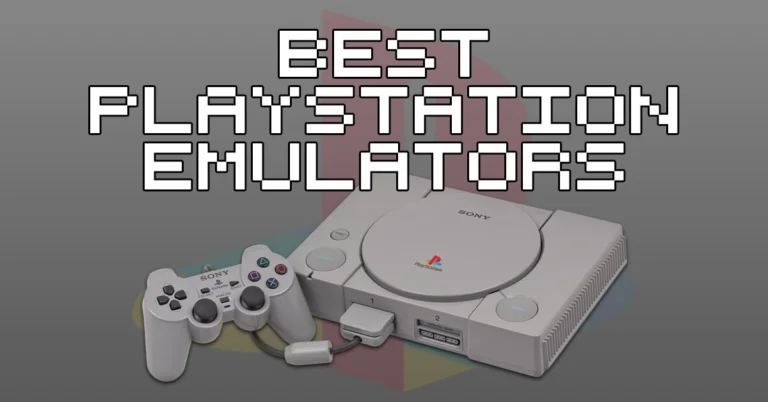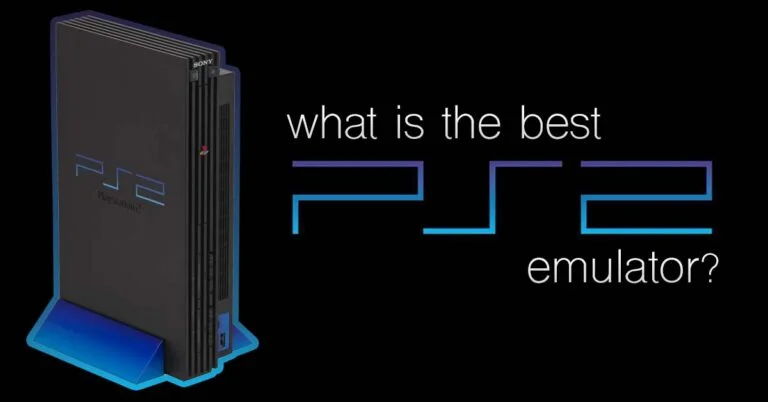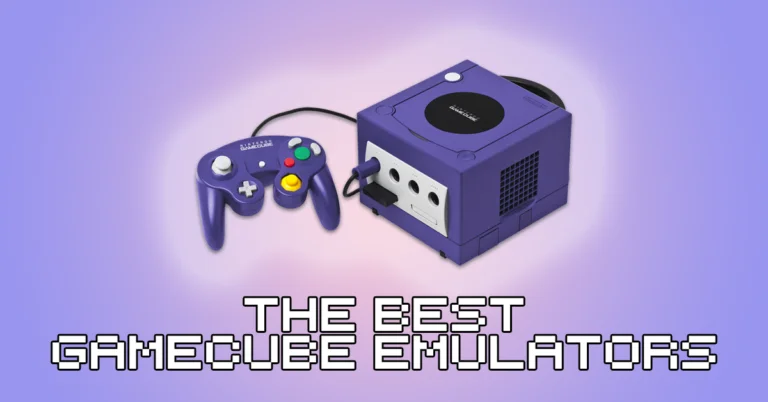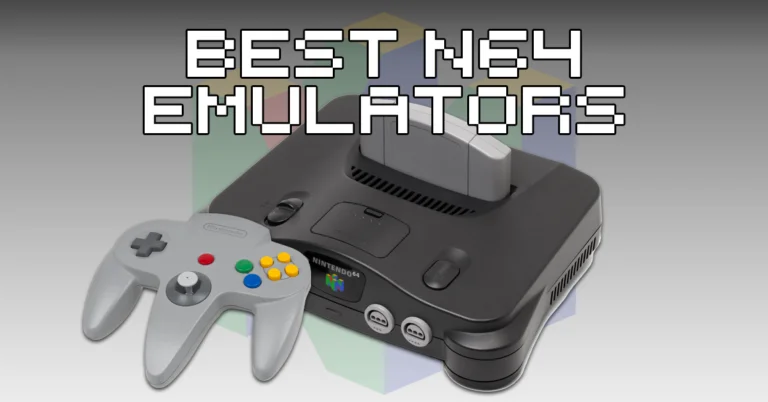Emulators
Looking for emulators to play your favourite retro games but unsure where to start? Get all the help you need with our comprehensive collection of emulator guides and recommendations which will get you feeling all nostalgic!
Popular Articles
Latest Articles
What Is An Emulator?
An emulator is either software or a piece of hardware that allows a system to ’emulate’ another computer system. For retro gaming fans, emulators are a revelation as they allow us to enjoy using the old consoles and computers that we used to enjoy.
Emulators provide an excellent way to continue to use legacy hardware/applications but with the added benefit of not having to maintain old hardware which can be prone to failure.
Emulators play a hugely important part in the desire to preserve software. In particular, retro gaming enthusiasts are huge advocates of emulators as it allows the preservation and accessibility of games that are gradually being lost to the degradation of media such as DVDs, CDs, Floppy Disks as well as cartridge-based hardware.
It is also a controversial subject involving many brands that still exist today that have made games previously purchased online unavailable for download.
What Are Emulators Used For?
Emulators are used for many different purposes, from business to entertainment, emulators have become a staple part of both industrial use and for personal use, especially retro game fans.
Emulators are commonly used for personal use, especially computer & game console emulators. There are many popular emulators around as well as ‘frontends’ that act as a user-friendly GUI between the actual emulator and the end user. Examples of emulators include PCSX2, which is a popular Sony PlayStation 2 emulator which is available for Windows, macOS & Linux.
In business, emulators are equally as common. For example, a team of developers use a mixture of both Windows PCs and Mac systems, however, there is a requirement that they all need to use a Windows application for a task.
This is where a form of ’emulator’ can come into use. Software called Parallels for Mac allows users to run ‘virtual’ instances of Windows, so they can efficiently access a Windows environment alongside their Mac OS.
Another very popular emulator product is RetroArch, this is commonly referred to as an emulator, but as mentioned above, it acts as more of a frontend and toolset which run emulator ‘cores’.
RetroArch makes the configuration of emulators and your games library much more accessible and easy to use. The difference between RetroArch to other emulator frontends is that it is easy to ‘one-click install’ emulator cores, making it an excellent all-in-one solution for retro gaming enthusiasts.
Another product called Launchbox is a well-regarded emulator frontend, this is available on Windows & Android devices and offers a very attractive frontend that can be used to manage your game collections along with comprehensive artwork, video, and database integrations to give a premium experience.
What Are The Most Popular Emulators?
There are now hundreds of emulators that exist that cover everything from emulating the original Pong home console to more present-day systems such as the Nintendo Switch. The best place to start is by looking at the most popular emulators currently available. The following are considered at present, the most popular emulators or emulator packages to use.
RetroArch
RetroArch is the choice for the majority of retro gamers out there. It is a free open-source package that is essentially just a frontend for emulators, but it does so much more than many other frontends out there. It actually has versions not just for PC, Mac & Linux, but also for Android, Xbox, Nintendo Switch, PlayStation 4, PSP, and PlayStation Vita.
RetroArch allows one-click installation of its emulator ‘cores’, which are packaged versions of popular emulators such as Dolphin for the Nintendo GameCube/Wii, PicoDrive for Sega systems such as the Master System & Genesis/Mega Drive, VICE for the C64 and Snes9X for the SNES.
RetroArch offers many core options for over 70 systems. It offers a huge amount of configuration, in addition to the emulator options of each emulator core, RetroArch also has a defined set of features that allow features such as netplay, video shaders, audio filters and cheats as well as game library management complete with artwork.

With no end in sight for the developments and updates it receives, RetroArch still remains one of the leading ways to play retro games on many systems and appears as though it will be for many years to come.
RetroArch is available from the official RetroArch website here.
RetroPie
RetroPie is a package designed primarily for Raspberry Pi. It is free and is a Linux-based package that utilises versions of both RetroArch and EmulationStation. There are also versions of RetroPie that can be used on Linux on a PC and Odroid devices with Ubuntu installed.
RetroPie is hugely popular and is one of the most affordable ways to play retro games. There are versions for the Raspberry Pi 1, Zero, Pi2, Pi3, Zero 2 W, and the Raspberry Pi 4 and 400 models.
Getting up and running with RetroPie is as easy as downloading an installation image from the RetroPie site, then copying it to a micro sd card and it is ready to boot. All you need to do is add your own game ROMs to the micro SD card, or alternatively a USB stick.
With RetroPie, you can emulate over 50 systems, including favourites such as the Genesis, NES, SNES, N64, PS1, PS2, GameCube, Neo Geo, Dreamcast, Amiga, C64, and many more.
Do You Need To Own The Game To Use An Emulator?
From a purely technical perspective, no. An emulator simply is a piece of software that emulates hardware. There are many homebrew titles and public domain games that are freely available and often included with many emulators.
If you intend to play games that were commercially available, it is suggested that you own the original.
It is also possible with many emulators to use the original media on the emulator. For example, if you have a CD/DVD drive on your device, the PS1 emulator ePSXe offers the ability to run games from the original CDs. PS2 emulator PCSX2 also offers the same functionality where you can play original PS2 DVDs.
As with anything where media and copyright is concerned, you must take responsibility for your own actions.
Are Emulators Safe?
Yes, emulators are safe to use – So as long as you are downloading reputable software! Using emulators is no different from downloading and using any other application online. It would help if you took all the typical precautions so as not to download anything that may compromise your device or online privacy.
Here are some quick tips to ensure you can stay safe online when using emulators:
- Ensure you know what you are downloading and where you are downloading from. This should seem obvious to most experienced internet users, but since emulation is a niche area, it is not unusual to have to download emulators directly from developer websites. Just do a bit of research before committing.
- Have anti-virus software installed. Again, this is nothing unusual for the average computer user. Good anti-virus software will help keep your computer protected from viruses and malware.
- Utilise anti-virus software browser extensions. These will help you further by flagging up any questionable websites as soon as you visit them, saving you from potentially downloading anything you wish you hadn’t!
- Only download software from reputable websites. This seems an obvious one, but it is easy to get roped into just downloading something from the first site on Google because it seems the quickest solution.
What Is An Emulator ROM?
A ROM is typically a dump/image of a game or piece of software, placed into a single file for use with an emulator. The term ROM can be used incorrectly when discussing game images, but is commonly used when talking about games and emulation.
It is important to differentiate the emulator and the ROM. The ROM is the game/software which is loaded into the emulator which is typically an application written to emulate hardware.
Do Emulators Cost Money?
Some emulators cost money, some are free. Typically, you will find more examples of emulators costing money at places like the Google Play Store, where there are lots of emulators, both free and paid apps.
There are also examples of emulators that cost money for the PC and Android. Redream, the Sega Dreamcast emulator is a good example here.
Redream offers a free version as well as a premium version, which is a one-time purchase of $6 (at the time of writing) which offers some improved functionality including increased upscaling offering high definition rendering improving visuals, increased amount of save state slots as well as a custom discord server role.

You will easily find an emulator meeting your needs for free though, you might just want to consider paying for an emulator should you require any specific functionality.
Do Emulators Have Better Graphics Than Original Hardware?
The benefit of emulators is that you are not restricted by the video output of the original hardware. Many emulators have upscaling features built in, which multiply the pixel count of the games to improve the fidelity on screen for the end user.
In addition to upscaling, emulators benefit from being able to use the latest video outputs at the highest resolution. The only limitation tends to be the maximum resolution of your display and the limit the developer has imposed on the amount of upscaling the emulator will offer.
It is not only resolution upscaling that emulators offer additional tools such as increasing anti-aliasing, to help with smoothing jagged edges and anisotropic filtering to help improve the appearance of textures, which is vital with emulating more recent retro systems such as the PS2 & GameCube/Wii.
Emulator Terminology
Emulators can be complex things, so to make it easier for the more casual retro gamers, we’ve compiled a list of commonly used terms in emulators along with a brief explanation of each term.
- ROMs – Files that contain the game data, usually copied from the original game cartridges or discs.
- BIOS – A file needed by some emulators to replicate the original system’s basic input/output system.
- Emulation – The process of mimicking the hardware and software of one system on another.
- Save State – A feature that allows the player to save the game at any point, which is not usually available in the original system.
- FPS (Frames per Second) – A measurement of how smoothly the game is running. Original consoles had a specific FPS, and emulators try to replicate it.
- Input Lag – The delay between pressing a button and seeing the game react.
- Plugins – Additional software components that can be added to an emulator to enhance or alter its functionality.
- Screen Filters – Options within emulators that change the visual style of the game, often to mimic old TVs or to improve graphics.
- Controller Mapping – Configuring the controls to suit the player’s preference or to emulate the original system’s controller layout.
- Console Emulator – Software that replicates a specific game console, like SNES, Genesis, or PlayStation.
- Multi-System Emulator – Software that can emulate multiple consoles.
- Emulator Frontend – A graphical user interface used to organize and access your emulators and games in one place.
- Backward Compatibility – The ability of a console to play games from its predecessors, often achieved through emulation.
- Pixel Aspect Ratio – The ratio of width to height for a single pixel, is important for accurately replicating the display of older systems.
- Overclocking – Running the emulated hardware at a higher clock rate than the original, often to improve performance.
- Homebrew – Games or applications created by hobbyists for retro consoles, often played via emulators.
- Netplay – A feature that allows for multiplayer gaming over the internet.
- ROM Hacking – Modifying a game’s ROM file to alter the game’s graphics, dialogue, levels, gameplay, or other elements.
- Patch – A file that can be applied to a ROM to change its data, often used for translations or mods.
- Debugging – A feature in some emulators that allows for the analysis and manipulation of the emulated code.
- Screen Resolution – The dimensions of the display in pixels.
- Shaders – Effects that can be applied to the graphics of an emulated game to achieve various visual styles.
- Speedrunning – A gaming culture where players attempt to finish a game in the shortest time possible, often using emulators to practice and optimize.
- TAS (Tool-Assisted Speedrun) – A speedrun that is created using tools provided by an emulator to perform actions faster or more precisely than would be possible by a human.

A lifelong avid gamer and computing enthusiast, Matt has decades of Retro Gaming experience. Now over 40 years old, Matt now even considers himself retro, but fortunately, nobody has developed a Matt emulator (not yet at least!).



